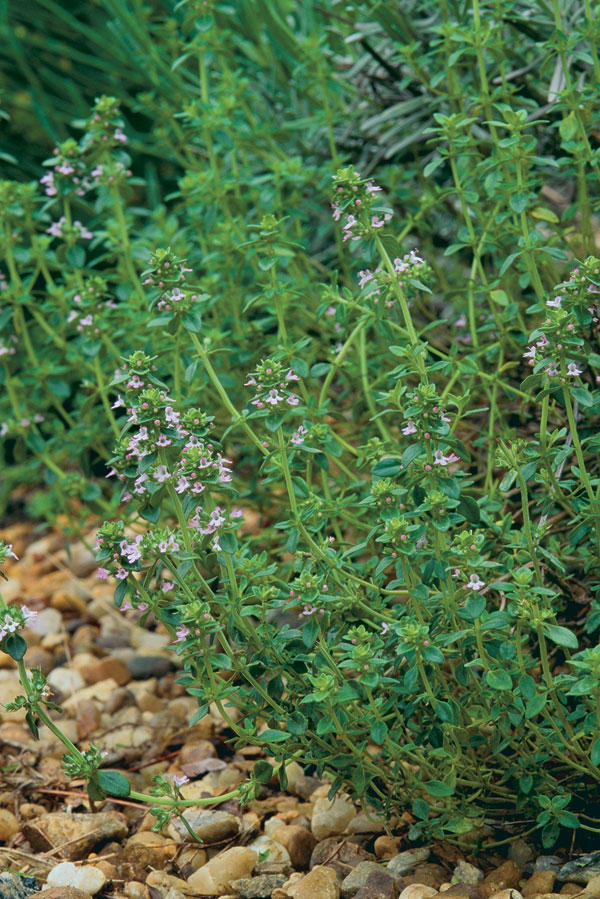
Back in the early 1960s, a friend of mine gave me a shoebox containing three thyme plants. I was living in Houston then, working on NASA’s manned space program. The challenge of growing these Mediterranean herbs in Houston’s perpetual Turkish-bath climate was just the kind of respite I needed after a day of testing intricate spacecraft systems. But I was a neophyte gardener. Two of the plants died gracefully within the first month. The third resisted my efforts to kill it for over a year. But in spite of the 100% mortality rate I’d achieved, I was hooked on thymes.
Since then, I’ve spent my free hours in the pursuit of growing, studying, and identifying thymes. I find their dynamic fragrances, their tiny flowers, and their varying growth habits compelling. I’m intrigued by their flavors, particularly by how certain thymes imitate the taste of unrelated things like lemon or caraway. I’m pleased to say that over the years, I’ve had much better luck growing thymes, primarily by mimicking their native habitat as closely as possible, and by learning how to prune the plants correctly.
To find the best thymes, pinch and sniff
The world of thymes is vast: Species, subspecies, cultivars, and hybrids abound. But when it comes to the kitchen, the players are few. There are only about half a dozen considered suitable for cooking. Out of this group, I find four to be most useful: French thyme, lemon thyme, oregano-scented thyme, and caraway thyme.
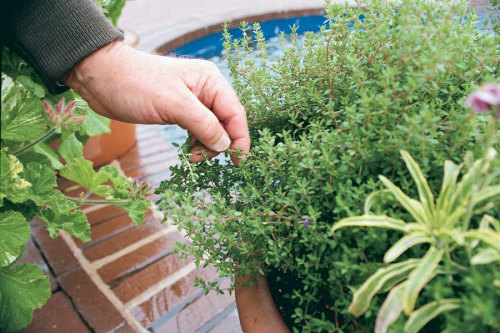
French thyme (Thymus vulgaris) is the one that most people know. The plant grows into an upright bush 12 in. to 18 in. high, and has small, diamond-shaped leaves with margins that curl back onto themselves. Have you ever stroked a plant of French thyme and then smelled your hands and thought of Vicks VapoRub? That’s because thymol, the dominant essence in French thyme, is the ingredient that gives the Vicks ointment its characteristic pungent odor. Don’t let that dissuade you from using French thyme in the kitchen, though. Its strong flavor complements fish, meat, cheeses, and many vegetables.
Lemon thyme (T. × citriodorus) has dark green leaves that are relatively large. It too has an upright habit, although it usually doesn’t get as large as French thyme. Two essence components, neral and geranial, together put the citrus in lemon thyme, which is probably the most useful of the culinary thymes. I find that lemon thyme goes well with vegetables and meats that aren’t too strong in flavor, like chicken and pork, and is especially good with fish.
Oregano-scented thyme (T. pulegioides) grows to about 10 in. high, with shiny, dark green leaves. Carvacrol, the flavor we know as oregano, is dominant in oregano-scented thyme. It can be used in the same way as French thyme, but I particularly like it in Italian and Middle Eastern dishes, where both tastes are appropriate.
Caraway thyme’s botanical name, T. herba-barona, stems from its use during the Middle Ages to flavor the huge roast called a baron of beef. Carvone is the dominant essence component in caraway thyme, as well as in caraway and dill seeds. I use caraway thyme in the same foods in which I use caraway seed—sauerkraut, breads, and to flavor a vinegar to season cooking greens. Unlike the first three, caraway thyme forms a broad, low mound of dark green foliage only about 4 in. tall. All four varieties have leaves that persist through the year, and summer blossoms ranging from pale lavender or pink to white.
Thymes vary plant to plant in how much flavor and fragrance they have. I always pinch and sniff and even taste a sprig before deciding which specimen of French thyme or lemon thyme to put in my garden. For the same reason, I don’t consider seeds to be a reliable source of new plants. When I buy a plant, I know what I’m getting; when I sow seed, I don’t. Taking cuttings from a friend’s plant is also a good way to get yourself a flavorful specimen—read on to see how to do this. If you can’t find a local source of plants, you’ll need to buy them by mail.
In the garden, a rock mulch and a lean diet
One of the single most helpful things I learned about growing thyme is to mulch it with light-colored gravel, preferably one of limestone composition. Clues to thyme’s natural affinity for limestone rocks and chalky soil are spelled out in the names of some of the ornamental species—graniticus, gypsicola, and dolomiticus. The stone-chip mulch has a therapeutic effect, reflecting ultraviolet rays onto the branches, helping the thyme to resist fungal diseases in my humid Virginia climate. Using rock also lends a sense of authenticity, of beauty and grace to the planting.If you don’t have gravel, sand also works well, but it doesn’t look quite as picturesque.
All thymes need full sun, well-drained, gritty soil, and good air circulation. Because the soil condition requirement isn’t what best suits vegetables, thymes are better off planted with sun-loving ornamentals or other herbs, rather than with the tomatoes and lettuces.
A diet that isn’t too high in nitrogen, which promotes leaves instead of flowers, also will yield more flavor for your kitchen. That’s because the glands that produce the essential oils are more concentrated in the flowering parts near the stem ends than in the larger and older leaves farther down the stem. For that reason, I fertilize only at planting time with a time-release, balanced formula that contains trace elements.
A good time to set out plants is in the spring, after all danger of frost is over. Many gardeners can also plant thyme in the early fall, as long as the plants have three or four weeks before the first frost to become established. Oregano-scented and caraway thymes are the hardiest of the four, thriving in areas where winter lows drop to the single digits. French thyme is the least hardy. If your winter temperatures stay below freezing for extended periods, you should count on either protecting French thyme or replacing it come spring. Thymes are shallow rooted, so keep watch for frost-heaved plants in winter, pressing them back into the ground with your foot.
Thymes adapt readily to being grown in containers. The only difference in culture is that container-planted thymes need to be watered more frequently than in-ground thymes. In this case, though, I’ve found that by adding some clay soil to the potting mix, I could stretch the time between waterings, with no ill effects.
Pruning twice a year makes a better plant
Plenty of people grow thyme and never prune it except to harvest stems for the kitchen. But correct pruning can make the difference between a thriving plant and a languishing one. I prune thyme twice during the growing season. First, right after the plant has finished blooming, I cut off the dead flower heads and generally shape up the plant. I prune for the second time about a month before the first expected fall frost. The purpose of this second pruning is to encourage new growth, which is hardier than mature stems, and better able to withstand the winter.
When pruning, it’s important not to cut back into the older, woody part of the plant. The soft, green stems put on more and sturdier growth than do older, brown stems. A woody thyme plant, while attractive in a bonsai sort of way, is a weak structural specimen and has a much-reduced area of active growth. Of course, every time you harvest stems for the kitchen, essentially you’re pruning the plant, so it’s best to apply the same principles.
You can’t have too much of a good thyme
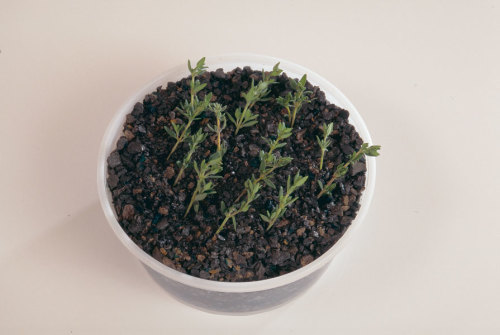
When I want to increase a plant, like my caraway thyme which has a particularly good flavor, I take stem cuttings. Propagating thyme vegetatively, rather than by seed, ensures me that all the progeny will be identical. I’ve found that the cuttings root easily in unscented, clay-based cat litter. The cat litter absorbs about eight times its weight in moisture, and the spaces between the granules encourage air circulation and help prevent rot.
To take stem cuttings, I clip non-flowering stems 4 in. to 5 in. long, making the cut just above where the stem becomes woody. Flowering stems can also work, but they’ll be more reluctant to form roots, because their hormones are directing them to make flowers instead of roots.
I strip the leaves off the lower two-thirds of the cutting, and then stick the stems deep into a pot of clean, unscented, clay-based cat litter. If the container is shallow, like the one in the photograph above, I run the cuttings in at an angle to give the stems plenty of length for sending out roots. When the pot is full of cuttings, I thoroughly moisten the litter and then place the pot in a shaded area and keep it moist. In a few weeks the cuttings have rooted enough to be transferred to small pots or a cold frame. The following year they’re ready to set out in the garden.
Thyme in the garden
- Plant in gritty, well-drained soil in full sun.
- For container-grown plants, use a clay-based soil to help retain moisture.
- Mulch with light-colored stone chips, pebbles, or sand, which reflect light and keep plants healthy and thriving.
- Prune after flowering and again a month before frost.
This article originally appeared in Kitchen Gardener #6 (December 1996).

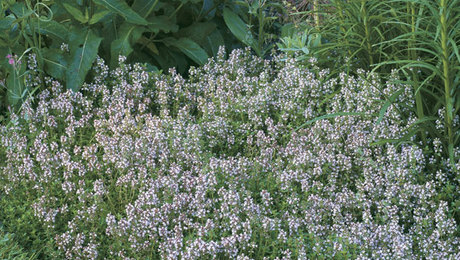
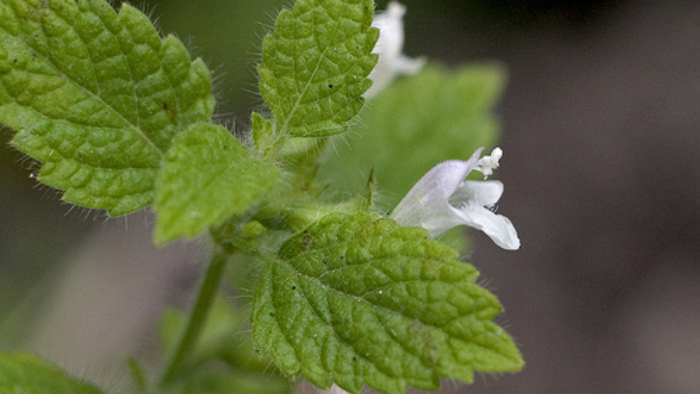
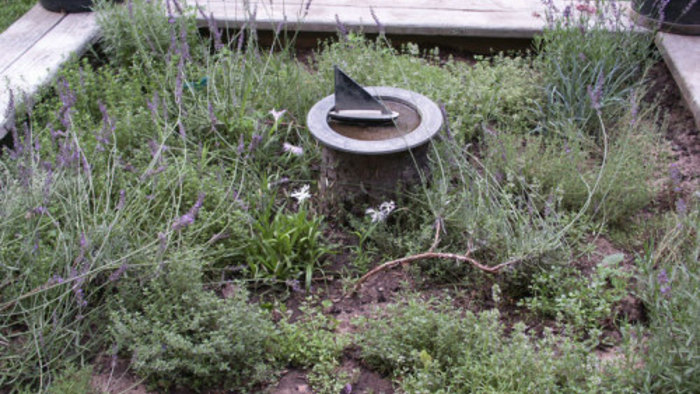













Comments
Log in or create an account to post a comment.
Sign up Log in